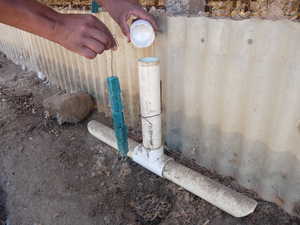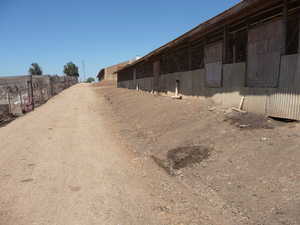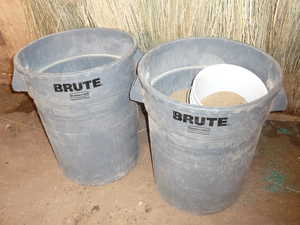Friday, September 10, 2010
Many of you produce your own eggs and may be wondering how the current chicken egg recall might affect you. Demand for your eggs may go up as more and more people are turning to locally produced eggs. But locally produced does not necessarily mean salmonella-free.
There are over 2500 strains of salmonella and the vast majority of these cause no problems to humans or poultry. Salmonella Enteriditis is the strain that is of greatest concern to the egg industry as this strain can actually infect the bird's ovaries (as opposed to most strains that cannot leave the gastrointestinal tract), allowing the bacteria to travel into the yolk of eggs forming in the oviduct. When these eggs are not completely cooked, humans can be infected.
There are things, however, that you can do to reduce salmonella levels on your farm:
1) Purchase ducklings from a reputable hatchery. At a recent NPIP conference that I attended in San Diego, a Mail Order Hatchery Salmonella Monitored category was established with guidelines for testing and sanitation. These changes normally take several years to take effect, however, so don't expect to see this official designation soon. But if a hatchery is testing for salmonella, you should be safer with their birds.
There are over 2500 strains of salmonella and the vast majority of these cause no problems to humans or poultry. Salmonella Enteriditis is the strain that is of greatest concern to the egg industry as this strain can actually infect the bird's ovaries (as opposed to most strains that cannot leave the gastrointestinal tract), allowing the bacteria to travel into the yolk of eggs forming in the oviduct. When these eggs are not completely cooked, humans can be infected.
There are things, however, that you can do to reduce salmonella levels on your farm:
1) Purchase ducklings from a reputable hatchery. At a recent NPIP conference that I attended in San Diego, a Mail Order Hatchery Salmonella Monitored category was established with guidelines for testing and sanitation. These changes normally take several years to take effect, however, so don't expect to see this official designation soon. But if a hatchery is testing for salmonella, you should be safer with their birds.

2) Do as much as you can to control rodents, wild birds, flies and cockroaches. Rodents are a proven vector of Salmonella Enteriditis. They will bring it to your farm and then carry it from pen to pen and from house to house. Controlling rodents is the single most important thing you can do to control salmonella. The T tubes shown in the picture above are an excellent method of poisoning rats and mice. All it takes is some PVC pipe, bait blocks and a wire. Hang the blocks so the bottom one is about 1.5" off the floor of the bottom tube. Periodically you put more blocks on the wire. It is important that the rodents always have access to blocks - especially for the rodents visiting your farm the first time. Normally several meals are required to kill the rat or mouse.
3) To reduce rodents it is also important you remove all vegetation and junk from at least 10' from your pens and buildings. Rodents don't like crossing empty ground on which they are exposed to predators.
3) To reduce rodents it is also important you remove all vegetation and junk from at least 10' from your pens and buildings. Rodents don't like crossing empty ground on which they are exposed to predators.

4) Purchase feed from mills that follow the principles in the "Recommended Salmonella Control for Processors of Livestock and Poultry Feeds" published by the American Feed Industry Association. By using pelleted or crumbled (which is pelleted and then broken) feed, all salmonella has been killed due the heat and steam required by the pelleting process. ? You may also want to use feed that has no animal products in it (fat, meat and bone meal, etc.) as these can be carriers of salmonella.
5) Store your feed so that rodents cannot access it. Wasted feed and sacked feeds on the ground are an open invitation to rodents. If possible, store it in plastic containers or metal feed tanks.
5) Store your feed so that rodents cannot access it. Wasted feed and sacked feeds on the ground are an open invitation to rodents. If possible, store it in plastic containers or metal feed tanks.

6) Make all efforts to produce eggs that are clean when they come out of the nests. Provide nest boxes before they start laying so they use them and add bedding as necessary to keep the floor and nests clean. If the eggs are dirty, wash them as soon as possible after laying. As most salmonella resides in the bird's gut, it will be present in the droppings. Keep the droppings off the eggs.
7) Chill the cleaned eggs as soon as possible. Chilling will not eliminate salmonella but will prevent its growth - making it more difficult to infect someone if by chance you do have any salmonella. The recommendations of the California Egg Quality Assurance Plan and the recently enacted USDA Salmonella Control Program are very similar to those described above if you have an interest in a more detailed program designed for large producers.
By following these recommendations, your ducks and geese will be better protected from salmonella.
I need your help for a future blog. Please send us the name of the feed company (not the feed store) that makes the sacked feed you buy at your local feed store. Very few companies make a waterfowl feed and our readers are often confused on which feed to use. We will contact all the feed companies sent to us (such as Purina, Ranch-Way, Modesto Milling, etc.), study their feeds and then recommend which to use for waterfowl in a future blog. So please send us the name of the feed company, and their phone number, website or city and state via the comment section below. Thank you very much!
7) Chill the cleaned eggs as soon as possible. Chilling will not eliminate salmonella but will prevent its growth - making it more difficult to infect someone if by chance you do have any salmonella. The recommendations of the California Egg Quality Assurance Plan and the recently enacted USDA Salmonella Control Program are very similar to those described above if you have an interest in a more detailed program designed for large producers.
By following these recommendations, your ducks and geese will be better protected from salmonella.
I need your help for a future blog. Please send us the name of the feed company (not the feed store) that makes the sacked feed you buy at your local feed store. Very few companies make a waterfowl feed and our readers are often confused on which feed to use. We will contact all the feed companies sent to us (such as Purina, Ranch-Way, Modesto Milling, etc.), study their feeds and then recommend which to use for waterfowl in a future blog. So please send us the name of the feed company, and their phone number, website or city and state via the comment section below. Thank you very much!